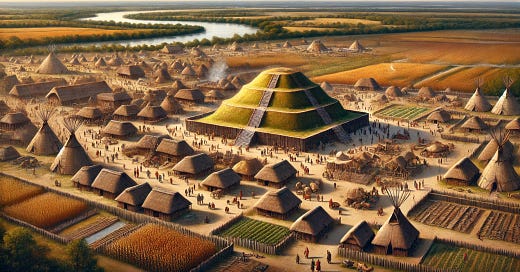Near the meeting point of the Mississippi, Missouri, and Illinois rivers about eight miles east of St. Louis in the U.S., where the land is fertile and the waters run slow, once stood one of the grand cities of the ancient world. It was called Cahokia. At its peak between 1050 and 1200 AD, the city was the largest and most sophisticated in the territory that's now the U.S. While estimates vary, about twenty thousand people called Cahokia home. For some context, that was about the same size as London then and would only be surpassed by a city in modern-day U.S. borders by Philadelphia in the mid-18th century.
Many mysteries and questions remain about Cahokia. But the prevailing belief is that the city evolved from small settlements of Native Americans who populated the region around the 8th century AD. These small settlements turned into a thriving metropolis likely in part due to the fertile floodplains rich with resources that drew people in to settle, farm, and trade. Researchers have also posited theories that another contributing factor was the city becoming a hub for religious practice.
Whatever the reasons, Cahokia grew into a planned city with neighborhoods, markets, ceremonial grounds, and a bustling central plaza. Its area covered between six and nine square miles, with more than 120 earthen mounds that served as platforms for temples, leaders' homes, burial sites, and celestial observatories. The largest of these, Monks Mound, remains an astonishing feat of human effort. Standing nearly 100 feet tall with a base larger than the Great Pyramid of Giza, it was constructed by moving an estimated 22 million cubic feet of earth, one basket at a time.
However, by the 13th century, Cahokia began to decline. The causes of its fall are still debated among historians and archaeologists. Some believe that as the forests were cleared for firewood and construction, erosion could have degraded the fertile land that sustained the population. Some argue that it was climate changes, including prolonged droughts, that may have disrupted food production. Other reasons include internal strife further strained the city.
Today, Cahokia is a UNESCO World Heritage site.
Sources:
ISEMINGER, WILLIAM R. “CAHOKIA: A MISSISSIPPI METROPOLIS.” Central States Archaeological Journal, vol. 33, no. 4, 1986, pp. 228–44. JSTOR, http://www.jstor.org/stable/43139658. Accessed 10 Mar. 2025.
Iseminger, William R. “MIGHTY CAHOKIA.” Archaeology, vol. 49, no. 3, 1996, pp. 30–35. JSTOR, http://www.jstor.org/stable/41771005. Accessed 10 Mar. 2025.
OpenAI. A digital illustration of the Ancient City of Cahokia. DALL·E, 10 Mar. 2025.
Weil, Elizabeth. "Lost Cities #8: Mystery of Cahokia – Why Did North America's Largest City Vanish?" The Guardian, 17 Aug. 2016, https://www.theguardian.com/cities/2016/aug/17/lost-cities-8-mystery-ahokia-illinois-mississippians-native-americans-vanish. Accessed 10 Mar. 2025.
Note: this story first appeared on the Historical Snapshots Chronicle.




